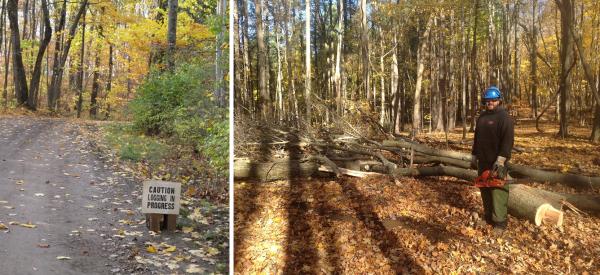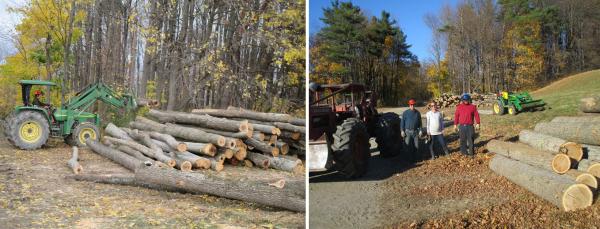Before winter sets in (and before next spring's sugaring season), we harvested about 40 cords of firewood and 7,000 board feet of lumber from an area adjacent to the current sugarbush. We'll be expanding the sap lines there this winter, adding about 450 more taps to the sugarbush. This will bring the total to about 1,500 taps. Depending on the year, this should yield anywhere from 450 to 750 additional gallons of maple syrup.
Harvesting trees before adding new lines is a good idea for a couple of reasons. First, harvesting trees that compete with maples for light, water, and nutrients can "release" the maples that we want to thrive. It is also really difficult to drop trees with sap lines in the way.Sugarmaker guru (and Shelburne Farms Board member) David Marvin helped us mark the trees for cutting, bringing his eye as both a sugarmaker and forester to the job. We dropped primarily hickory and basswood trees that were competing with the maples, and we also harvested trees that looked like they were in decline (leaning and dying) and might fall on sap lines. Richard Lavine, who has harvested forest stands at the farm since the 1970s, and Crops and Woodlands Assistant Jeremy Bessette dropped and skidded the felled trees to the log yard. Woodlands Manager Marshall Webb, Josh Carter and myself cut the logs to length and sorted them into firewood and sawlogs.
We decided to manage this particular area as a sugarbush because the forest stand was already dominated by maples, and it is located in the existing sugarbush drainage area. This means the sap will logically flow down slope to the collection tank. Where the forest composition started changing to oak dominant, with fewer maples, we stopped marking trees because it was obvious that the stand was not logically a sugarbush.Whenever we harvest, we always have forest stand diversity on our minds. It’s one of the goals of our sustainable forestry management plan. Although the logging decreased diversity in that area to some extent in the short-term, opening up the tree canopy will encourage diversity in the seedlings that regenerate. This will make the stand more resilient in the future if climate change starts to favor oak and hickory over maple. The area is also part of a larger forest stand that remains very diverse.
Overall, harvesting from this area helped us reach two goals--sugarbush expansion and firewood needs for 2017. The farm uses about 30 cords of firewood a year (for the inn and on-site home heating), so this 40-cord harvest is perfect. Now, with the firewood in, and the the sap lines checked (we’ll do another check in late winter/early spring), we’re just about ready for the snow to fly!
Next spring, be sure to find Shelburne Farms home-grown syrup at our Welcome Center and Farm Store -- from our taps to your table!
Here are a few photos of some other "housekeeping" we've been doing around the woodlands:




